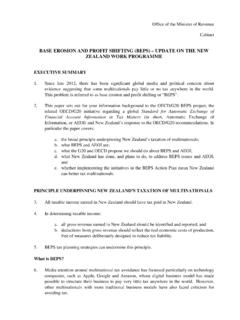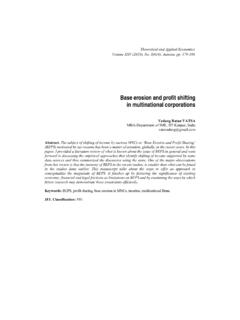Transcription of OECD’S BEPS PROJECT - skpgroup.com
1 Mumbai | Pune | Hyderabad | New Delhi | Chennai | BengaluruOECD S BEPS PROJECTWhy BEPS will change the way you operate? 2015 SKP Business Consulting LLP. All rights reserved. BEPS PROJECT : Trigger Points BEPS PROJECT : Action Plans Action Plans with Focussed Transfer Pricing Implications Other Action Plans: Transfer Pricing Implications BEPS PROJECT Impact: SKP InsightsCOVERAGEBUILDING UPTO BEPS 2015 SKP Business Consulting LLP. All rights reserved. Globalisation benefited domestic economies and impacted corporate income tax regimes across countries As the economy became more globally integrated, it opened up opportunities for MNEs to greatly minimise their tax burden For companies tax is a cost feel legitimate right to reduce it especially in challenging economic conditions post global financial crises Cash-strapped governments under significant pressures to reduce deficits Simultaneously countries are competing for profitable investments Taxation systems have not kept pace with changes in the business model Digital economy and increasing globalisation of business BACKGROUND INFORMATIONTax Evasion versus Tax Planning and Avoidance A Big Moral Debate 2015 SKP Business Consulting LLP.
2 All rights TRENDSS tarbucks not a bean in taxes, thanks to transfer pricingAmazonWith sales of billion reports tax paid of million ( ) in UKApple uses subsidiaries to dodge billions in taxesUS Senate Panel alleged that Apple is using so-called cost-sharing agreement to transfer valuable intellectual property assets offshore and shift resulting profits to tax haven jurisdictionsDolce and Gabbana stylists face 320 million tax fraud caseAccused of evading more than 400 million in tax when they sold their D&G and D&G brand to a holding company Gado, which they set up in Luxembourg in 2004 Starbucks UK sales in 2011 were worth 398 million, but paid nil taxes by charging UK operations high prices for use of logo GoogleUK unit paid 6 million to treasury in 2011 on UK turnover of 395 million ( ) 2015 SKP Business Consulting LLP. All rights FOLLOW 2015 SKP Business Consulting LLP.
3 All rights PROTESTS 2015 SKP Business Consulting LLP. All rights erosion and Profit Shifting (BEPS) Tax planning, which exploits gaps in tax rules, making profits shift to locations with little or no activity and having low taxes Three popular mechanisms for profit shifting are Hybrid Mismatch Special Purpose Entity/Vehicle Transfer Pricing Not always illegal, but taking advantage of current archaic tax rules that is disassociated with today s environmentBASE erosion AND PROFIT SHIFTINGBEPS arises because under existing rules MNEs are often able to artificially separate allocation of their taxable profits from the jurisdiction in which these profits OECD 2015 SKP Business Consulting LLP. All rights reserved. Group of G20* countries realised the need of preventing BEPS and approached OECD to address the issue related to BEPS OECD published a report on BEPS in February 2013 In July 2013, OECD released an Action Plan on BEPS which was presented to the meeting of G20 Finance Ministers in Moscow Action Plan covers 15 specific which are broadly to be achieved over a 2 year period by end of 2015 OECD BEPS PROJECT *Worldslargestadvancedandemerging economieswhichincludeArgentina,Australia ,Brazil,Canada,China,France,Germany,Indi a,Indonesia,Italy,Japan,SouthKorea,Mexic o,Russia,SaudiArabia,SouthAfrica,Turkey, UnitedKingdom,UnitedStatesofAmericaandEu ropeanUnion 2015 SKP Business Consulting LLP.
4 All rights to the international taxation landscapeBEPS ACTION PLAN Action 6:Prevent treaty abuse Action 7:Prevent the artificial avoidance of permanent establishment status Action 8:Consider transfer pricing for intangibles Action 9:Consider transfer pricing for risks and capital Action 10:Consider transfer pricing for other high-risk transactions Action 15:Development of a multilateral instrument for amending bilateral treaties Action 11:Establish methodologies to collect and analyse data on BEPS and actions addressing it Action 12:Require taxpayers to disclose their aggressive tax planning arrangements Action 13:Re-examine transfer pricing documentation Action 14:Making dispute resolutions more effective Action 2:Neutralise the effects of hybrid mismatch arrangements Action 3:Strengthen CFC rules Action 4:Limit base erosion via interest deductions and other financial payments Action 5:Counter harmful tax practices more effectively, taking into account transparency and substance Action 1:Address the tax challenges of the digital economyACTION PLAN ON base erosion AND PROFIT SHIFTING (BEPS) 2015 SKP Business Consulting LLP.
5 All rights PROJECTTIMELINEOECD BEPS Action Plan An ambitious timelineJune 2012 PROJECT announced/startedFebruary 2013 Release of document addressing base erosion and Profit Sharing (BEPS)July 2013 Release of Action Plan with 15 separate actions/work streamsSeptember 2014 Release of recommendations pertaining to 7 out of 15 Action Points and Oct/Nov additional 2 Action PointsDecember 2015 Completion of reminder Action Plan2016 and onwardsMonitoring additional/on-going complianceJul 2012 Feb 2013 Jul 2013 Sep/Oct/Nov 2014 Sep 2015 Dec 2015 2016 onwards 2015 SKP Business Consulting LLP. All rights BEPSACTION PLANSA ctionParticularsExpected OutputTimeline1 Addressing tax challenges of a digital economyReport identifying issues raised by digital economy and possible actions to address themSeptember 20142 Neutralising effects of Hybrid Mismatch Arrangements Changes to model tax convention and recommendations regarding the design of domestic rulesSeptember 20143 Strengthening Controlled Foreign Company (CFC)
6 RulesRecommendations regarding the design of domestic rulesApril 20154 Limit base erosion via interest deductions and other financial paymentsRecommendations regarding the design of domestic rules and changes to transfer pricing guidelinesDecember 20145 Countering harmful tax practices more effectively, taking into account transparency and substance Finalise review of member country regimes, strategy to expand participation to non-OECD members and revision of existing criteriaSeptember 20146 Preventing granting of treaty benefits in inappropriate circumstancesChanges to model tax convention, recommendations regarding the design of domestic rulesMay 2015(Revised Draft Released)7 Preventing the artificial avoidance of PE statusChanges to model tax conventionMay 2015(Revised Draft Released) 2015 SKP Business Consulting LLP. All rights BEPSACTION PLANSA ctionParticularsExpected OutputTimeline8 Assuring transfer pricing outcomes are in-line with value creation intangiblesChanges in transfer pricing guidelines and possibly to model tax conventionDecember 2014 April 2015 June 20159 Assuring transfer pricing outcomes are in-line with value creation risks and capitalChanges in transfer pricing guidelines and possibly to model tax conventionDecember 201410 Assuring transfer pricing outcomes are in-line with value creation other high risk transactionsChanges in transfer pricing guidelines and possibly to model tax conventionNovember 2014 December 2014 February 201511 Establishing methodologies to collect and analyse data on BEPS and actions to address themRecommendations regarding data to be collected and methodologies to analyse themApril 201512 Recommending
7 Mandatory disclosure rulesRecommendations regarding the design of domestic rulesMarch 201513Re-examining and providing guidance on transfer pricing Documentation and Country-by-Country Reporting Changes in transfer pricing guidelines and recommendations regarding the design of domestic rulesSeptember 2014 June 201514 Making dispute resolution mechanisms more effectiveChanges to model tax conventionDecember 201415 Developing a multilateral instrument and modifying bilateral tax treatiesReport identifying relevant public international law and tax issues and develop a multilateral instrumentSeptember 2014 TRANSFER PRICING ACTION PLANS 2015 SKP Business Consulting LLP. All rights pricing landscape continues to evolve, heralding enormous future changesTRANSFER PRICING ACTION PLANSA ctionParticularsCurrent Status8 Assuring transfer pricing outcomesare in-line with value creation intangiblesSep 2014 Revision of transferpricingguidelines with respect tointangiblesDec 2014 Revisionof transfer pricing guidelines (includes intangibles, risks, re-characterisation and special measures)Apr 2015 Transferpricing guidelines with respect to CostContribution AgreementsJun 2015 Transfer pricing guidelines relating to hardtovalue intangibles9 Assuring transfer pricing outcomes are in-line with value creation risks and capitalDec 2014 Revisionof transfer pricing guidelines (includes intangibles, risks, re-characterisation and special measures)
8 10 Assuring that transfer pricing outcomes are in-line with value creation other high risk transactionsNov 2014 Transfer pricing guidelines relating to low value-adding intra-group servicesDec 2014 Revisionof transfer pricing guidelines (which includes intangibles, risks, re-characterisation and special measures)Transfer pricing aspects of cross-bordercommodity transactionsUse of profit splits in the contextof global value chains13 Guidance on transfer pricing documentation and Country-by-Country reportingSept 2014 Guidance on three tiertransfer pricing documentationJun 2015 Release of implementation package for CbC Reporting 2015 SKP Business Consulting LLP. All rights PLAN 8: INTANGIBLESKey features of Action Plan and major changes Broader definition of intangible property (6 specific categories) Allocation of returns should be in line with value creation Ownership of intangibles and entitlement to returns Special focus on marketing intangibles and R&D arrangements Inclusion of Valuation Techniques as part of the five OECD transfer pricing methods Detailed guidance on local market features (Location Savings), assembled workforce and MNE group synergies Transfers of hard to value intangibles Distinguish between anticipated and actual remuneration and guidance on treatment of profits or losses relating to unanticipated events (ex-post returns) and sharing of same between MNE group members Situations may demand use of transactional profit split method Guidance on Cost Contribution Arrangement (CCAs)
9 2015 SKP Business Consulting LLP. All rights PLAN 9: RISKS AND CAPITALKey features of Action Plan Assuring transfer pricing outcomes are in line with value creation in areas of risk and capital Crucial to delineate inter-company transactions commercial and financial relations Enhanced focus on the risk allocation aspects expressed as well as implicit risks should be identified and considered for determining arm s length nature Inappropriate returns should not accrue to an entity solely because it has contractually assumed risks or has provided capital Non-recognition of related party transaction when the transaction does not have the fundamental economic attributes of arrangements between unrelated parties Sets out options for potential special measures to reduce the possibilities for BEPS that are either within or beyond arms length principle 2015 SKP Business Consulting LLP.
10 All rights PLAN 10: HIGH RISK TRANSACTIONS Intra-group low-value adding services a simplified approach Defining intra-group low value adding services Are of supportive nature Are not a part of the core business of the MNE group Do not require the use of unique and valuable intangibles and do not lead to the creation of unique and valuable intangibles Do not involve the assumption or control of substantial or significant risk and do not give rise to the creation of significant risk Determination of Arm s Length Price (ALP) Determination of cost pools and allocate costs to those group companies which benefit from those services Suggested profit markup of 2-5% Relevant documentation to be maintainedMeasures proposed would help reduce the scope for erosion of tax base through management fees and Head Office expenses 2015 SKP Business Consulting LLP.











